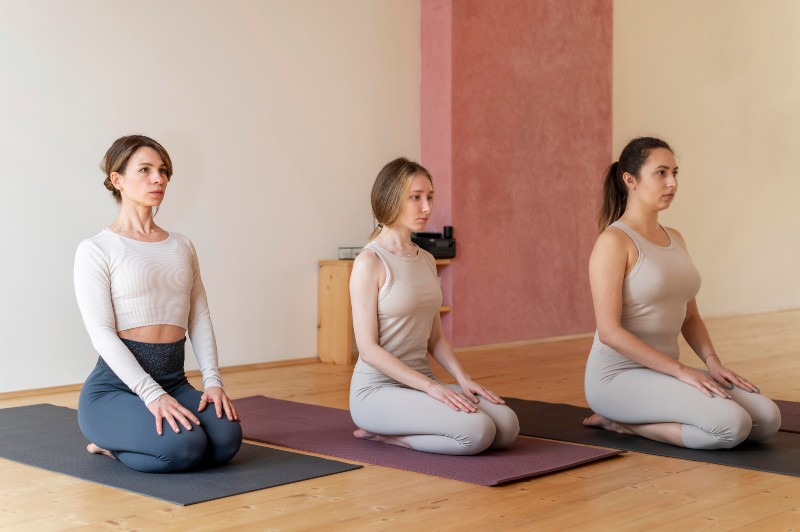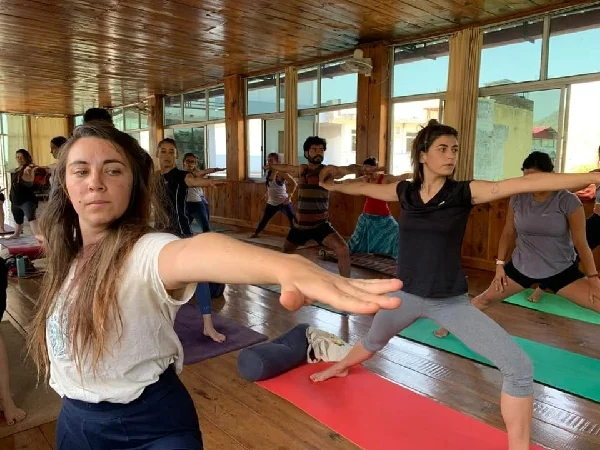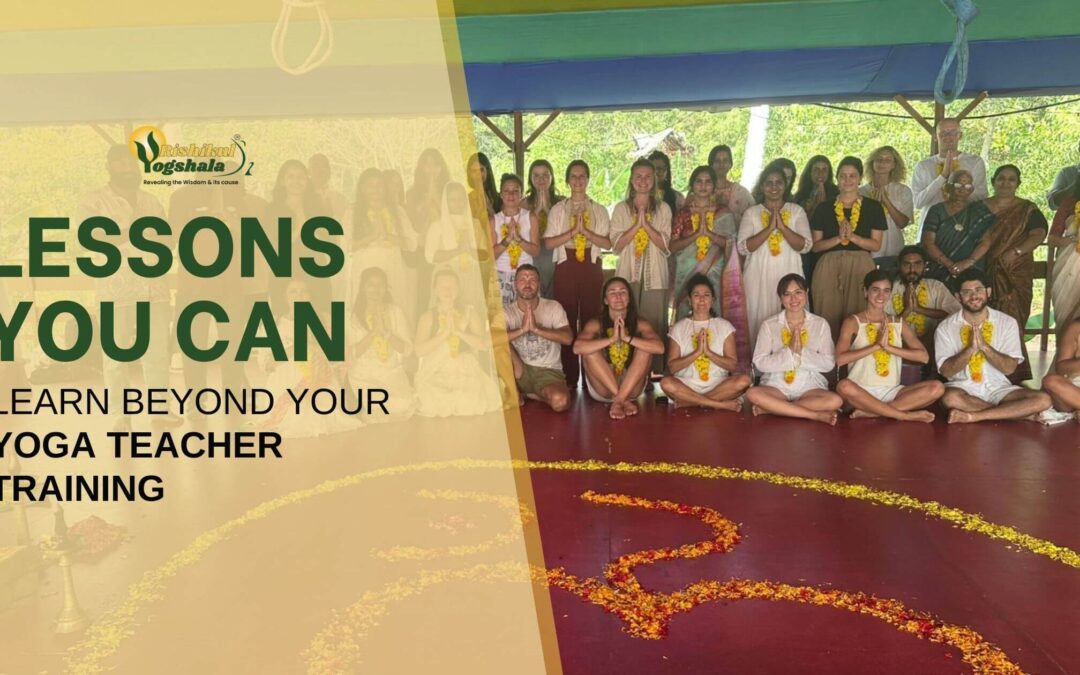What Is The Difference Between (RYT) And (E-RYT)?
- Blog
- /
- Yoga Teacher Training and...
- /
- What Is The Difference...

With the arrival of spirituality and improving mental health post-COVID, learning, doing, and teaching yoga has been the talk of the town lately. Subsequently, more people are expressing interest and effort in yoga teacher training programs.
For the most part, people want to plant the seeds or upskill themselves in yoga teaching. This is the main reason they pursue these programs and even move to a newer country like India for the same.
If you are confused or overwhelmed by what RYT and E-RYT essentially entail, stay tuned to learn more about them and gain clarity.
Understanding the Basics: What Is RYT?
RYT meaning refers to a Registered Yoga Teacher, a designation given to individuals who have completed a certified yoga teacher training program recognized by Yoga Alliance. A Registered Yoga Teacher is an accreditation given by Yoga Alliance. Yoga Alliance is the international organization that manages the standards for those teaching yoga as well as for schools offering the said training. To achieve the status, one has to complete 200 hours in a school accredited by Yoga Alliance.
Requirements for Becoming an RYT
One should accomplish the following if one aims to be a yoga instructor and have the status of RYT:
- Complete 200 Hours of Yoga Teacher Training from a school accredited by Yoga Alliance.
- Apply to register with Yoga Alliance.
- Commit to continuous education and practice based on the code of ethics of Yoga Alliance.
Becoming an RYT places you in the Yoga Alliance’s international directory, which is often a useful resource for future employers and students seeking to find qualified teachers.

The Benefits of Being an RYT
An RYT unlocks the world of opportunities for yoga teachers.
- Legitimacy and credibility because Yoga Alliance is recognised worldwide.
- Many yoga studios and gyms require or prefer their teachers to hold this certification.
- It shows commitment to the practice and to the profession, therefore fostering trust with potential students.
But it does not end there. Experienced teachers are eligible to take the next step by moving towards the E-RYT level.
500 Hours of Advanced Yoga: Taking Your Practice to the Next Level
Yoga Teacher Training in progressive steps—the 500 Hour advanced level would complete the entire process for practitioners looking to improve their expertise and teaching skills after passing through foundational 200-hour yoga teacher training. The advanced study would concentrate more on details of yoga, such as more complex asanas, advanced teaching methodology techniques, and a deep understanding of yoga philosophy and anatomy.
What Is a 500 Hour Yoga Teacher Training?
This training comprises 200 hours of foundational training plus 300 Hours of an advanced course. Taken together, they constitute an integral program which brings a yoga teacher’s knowledge and powers to a profoundly more complete degree. It’s a basis-beyond-the-basics type of course, enabling students to revise their personal practice while also arming them with the knowledge to teach more advanced students.
This training is for already RYT-certified people who want to:
- Expand their knowledge on certain topics, such as therapeutic yoga, advanced alignment, or specialty yoga forms like restorative yoga.
- To enable them to perform efficaciously in teaching students at different levels, including intermediate and advanced practitioners.
- Learn more about yoga philosophy, breathwork, and meditation.
Why Choose 500 Hours of Advanced Yoga Training?
The 500 Hour Yoga Teacher Training is a comprehensive offer for those who are truly interested in becoming masterful yoga instructors. Of course, here are a few of the good reasons why advanced yoga teachers would choose this certification:
1. Mastery of Complex Asanas and Techniques
The intervention goes a little deeper into practices and sequences, hence giving a guide with confidence to the students to go through practices in their entirety. From mastering inversions and arm balances to having knowledge about deeper variations of most common asanas, 500 Hour TTC improves the ability of a teacher to provide guidance toward classes that differ with precision and safety.
2. Deeper Knowledge of Yoga Philosophy
Although the basic 200-hour program includes some teachings about yoga philosophy, the 500 Hour Training delves much deeper. Here, students participate in extended studies on the Yoga Sutras and the Bhagavad Gita, as well as other spiritual texts. This rich study would allow teachers to share not only the physical practice but also the wisdom of yoga’s spiritual traditions.
3. Advanced Teaching Methodology
A 500 Hour Yoga Teacher Training program is marked by the development of a more refined set of teaching skills. This can include making classes appropriate for levels of students, from beginners to advanced practitioners, as well as deepening into the art of adjustments, modifications, and even therapeutic approaches.
4. Specialized Certifications
Many 500 Hour TTC programs allow you the opportunity to specialize in areas such as prenatal yoga, therapeutic yoga, or Ayurveda. Specialized certification helps in finding a niche within the yoga teaching world, which is competitive. This way, teachers can offer classes targeted toward special needs or demographics.
5. Become an E-RYT 500
Upon completion of a 500 Hour Yoga Teacher Training and teaching experience, a yoga teacher is eligible to apply for E-RYT 500 status, that is, Experienced Registered Yoga Teacher at the 500 Hour level. This is the most prestigious form of recognized certification by the Yoga Alliance and reflects significant teaching experience as well as expertise.

Also Read – How to Become A Registered Yoga Teacher with Yoga Alliance
What Is E-RYT?
The E-RYT is the advanced certification provided by Yoga Alliance with an ‘E’ that stands for Experienced Registered Yoga Teacher. This certification classifies someone as having finished the 200 Hours of Yoga Teacher Training but also includes teaching experience.
Requirements for E-RYT Certification
To achieve this level of certification, one needs to:
1. You must be a registered RYT.
2. Complete at least 1,000 teaching hours after having obtained the RYT.
3. You have taught yoga for more than two years.
The E-RYT symbolizes experience along with devotion. RYTs, or experienced teachers, are considered to be more efficient as well as proficient in running training courses for teachers.
The Advantages of E-RYT Certification
E-RYT status enjoys several privileges, including:
- Right to operate yoga teacher training courses.
- Higher recognition within the yoga community and further prospects at employment.
- Being on the list of experienced teachers on Yoga Alliance’s site will make it easier for studios and students to find and then trust you.
Many yoga instructors with years of experience attain E-RYT status to lock in their teaching careers because this status shows a higher level of expertise.
Key Differences Between RYT and E-RYT
Even though both RYT and E-RYT are equivalent titles in yoga teaching, the differences between the two are quite distinct. So now, let us outline their differences so you can create a clear picture in terms of the roles and requirements.
1. Levels of Experience
RYT: Graduate of 200 Hour Teacher Training program in yoga.
E-RYT: Completes the same 200 Hour training program but has taught yoga for at least two years, having taught 1,000 hours.
2. Teaching Experience
RYT: Can train students but cannot train teachers or prepare courses for training.
E-RYT: Beyond teaching classes, the E-RYT can lead yoga teacher training courses, thus becoming eligible for many more leadership roles in the yoga community.
3. Status in the Yoga Community
RYT: Eligible to teach, but a new teacher by the standards of the yoga community.
E-RYT: Respected professional with a better chance to be employed and paid more than a Registered Yoga Teacher.
4. Continuing Education
RYT: It is expected to maintain the Yoga Alliance continuing education requirements, which entail a specified number of training hours every three years.
E-RYT: Continues to have continuing education requirements but, for the most part, is free to elect advanced training and specialisations.

Why Upgrade from RYT to E-RYT?
Many yoga teachers pursue an E-RYT certification after they have gained teaching experience for the reason that it provides them with more opportunities for their teaching profession. Certified E-RYT teachers can train fresh instructors, conduct workshops, and lead training courses. Through this, they are not only progressing themselves but will also deepen their practice and serve the community of yoga more meaningfully.
In addition, studios often prefer to hire E-RYTs for more complex roles, such as managing yoga teacher training sessions or leading special workshops. It also demonstrates a teacher’s lifelong learning commitment and diligent self-improvement, which can help one stand out in this competitive field.
Also Read – RYT-200, RYT-300, RYT-500 – Yoga Instructor Levels
Exploring Specialisations
Both RYTs and E-RYTs may specialize in various aspects of yoga, such as prenatal yoga, teaching children, and restorative yoga. Specializations allow the instructors to specialize in populations of students or even certain styles of yoga, which helps develop the quality of teaching they deliver.
Final Thoughts
You will have made yourself well aware if you are looking to be a new candidate in the field or searching for a promotion in qualifications. First, a newly qualified teacher can be rewarded with RYT status, but while the RYT status is very good for any new instructor, the E-RYT title has a lot more implications, as it can help guide a teacher training program, among many other benefits.
Both of these certifications will bring you many unique benefits as a yoga teacher. Each one depends on your purpose for teaching. If, as a teacher, you would love to take your practice deeper and make a larger impact in the world of yoga, E-RYT certification would be a truly fulfilling next step on the journey.
Explore more about transformative 200 Hour Yoga Teacher Training India, 300 Hour Yoga Teacher Training India, and Ayurveda Retreat In India to deepen your practice and improve your well-being.








